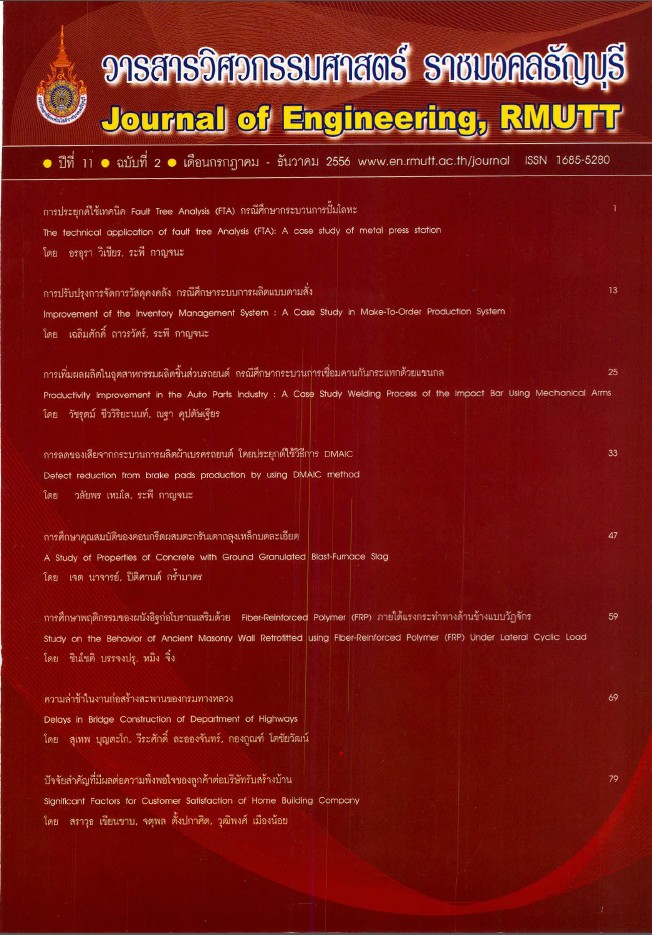Defect reduction from brake pads product ion by using DMAIC method
Main Article Content
Abstract
This research aims to reduce the amount of defects generated within the process of brake pad production by using DMAIC method stage of Six Sigma. According to the case study company's target, the amount of defects caused by pad crack problem should be decreased by 30%. The cure pressing process of disc brake pad model X068 production is selected for this study. In order to accuracy and precision measurement system, the specification of disc brake pad is controlled with the compression value ranging from 50 - I00 micron. The research methodology consists of 5 steps: ( 1) Define phase, the process capability index of disc brake pad production is evaluated, (2) Measure phase, the root causes of problem are determined. (3) Analysis phase, each one factor is analyzed. (4) Improve phase, the design of experiments (DOE) with 2[subscript k]
Full Factorial is used to investigate the relationship and the optimal value of each factor. and (5) Control phase. the statistical process control (SPC) is applied to control the process. After improvement by implementing the DMAIC method. it found that the scrap rate is reduced from 60.37%(40.46 1 PPM) to 39 .R7%( 17,090 PPM) of al l defect rate or about 17,090 PPM. Thus, with this improvement the amount of defects can be reduced by 36.75% of company policy.
Article Details
The manuscript, information, content, picture and so forth which were published on Frontiers in engineering innovation research has been a copyright of this journal only. There is not allow anyone or any organize to duplicate all content or some document for unethical publication.
References
หนังสือพิมพ์บางกอกโพสต์ 2553. ข่าวธุรกิจอุตสาหกรรมยานยนต์ สภาอุตสาหกรรมแห่งประเทศไทย
(สอท), [ออนไลน์ เข้าถึงได้จาก http:/ www.bangkokbiznews.com (10 มิถุนายน 2553).
กิตติศักดิ์ พลอยพาณิชเจริญ, 2542. การวิเคราะห์ระบบการวัด. พิมพ์ครั้งที่ . กรุงเทพมหานคร สมาคม
ส่งเสริมเทคโนโลยี (ไทย-ญี่ปุ่น).
พงศ์ สกุลคลานุวัฒน์, 2551. การถดของเสียแขนจับหัวอ่านด้วยวิธีการซิกซ์ ชิกม่า. การประชุมวิชาการข่ายงานวิศวกรรมอุตสาหการ.
วสันต์พุกผาสุข,2550.การลดของเสียจากกระบวนการชุบโครเมี่ยม โดยประยุกต์วิธีการชิกซ์ซิกม่ากรณีศึกษาบริษัทในอุตสาหกรรมชุบโครเมี่ยม.ภาควิชาวิศวกรรมอุตสาหการคณะวิศวกรรมศาสตร์,สถาบันเทคโนโลยีพระจอมเกล้พระนครเหนือ.
T.N. Goh. 2002. Six sigma quality management,Journal of Quality Engineering 18(5): 403-410. 14.
Nicholas Roth, 2010. Process improvement for printing operations through the DMAIC Lean Six Sigma approach: A case study from Northwest Ohio, USA, Journal of Lean Six Sigma, Vol. 1 Iss: 2, pp.119 - 133.
Sameer Kumar and Michael Sosnoski, 2009. Using DMAIC Six Sigma to systematically improve shop floor production quality and cost, Journal of Prod uctivity and Performance Management Vol.58 No.3.
Wichai Chattinnawat, 2008. Methodology of DMAIC with Why-Why Analysis in a Hierarchical Decision Procedure: A Case Study of Quality Improvement of Polarization Maintain and absorptionReducing (PANDA) Fiber Connectors, Journal of Industrial Engineering, ICMIT 2008.
J.P.C. Tong and F. Tsung, 2004. A DMAIC approach to printed circuit board quality improvement,Article of Manufacturing Technology, 23(7):523-531.
Clairton A. Siebra, Paulo H.R. Costa and AndreI N Santos, 2009. Improving the Handsets Network Test Process via DMAIC Concepts, Research of CIn/SIDI-Samsung Laboratory,8248/91.
Wang Zhiying and Sun Jing, 2006. Application of DMAIC on Service Improvement of Bank
Counter, Service Systems and Service Management, 2006 International Conference on Vol.1:726-731.


